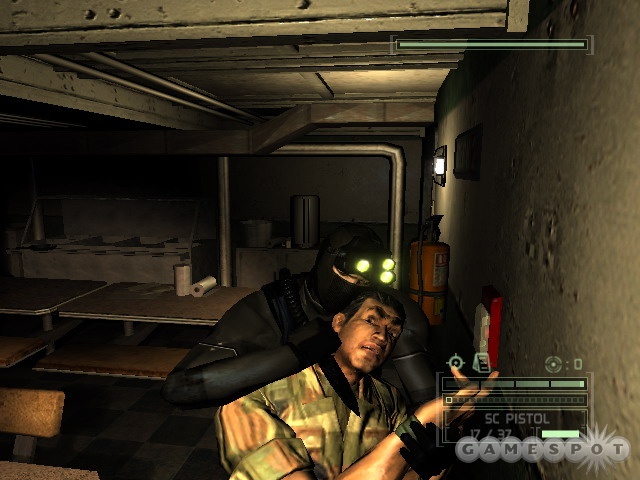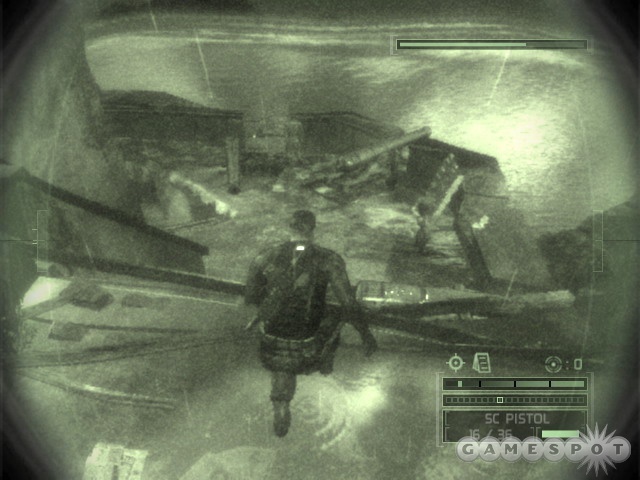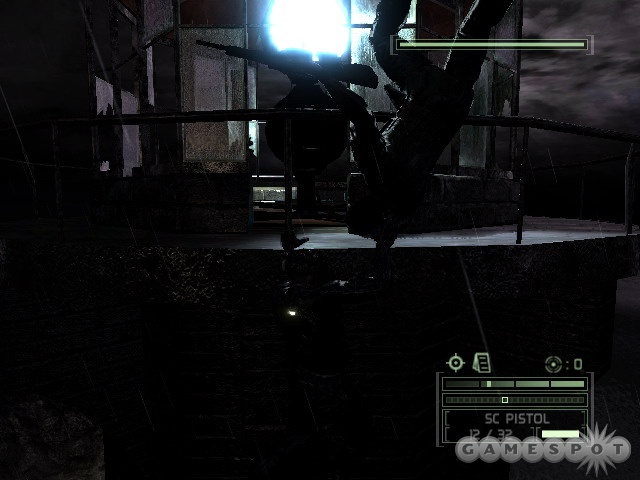Tom Clancy's Splinter Cell Chaos Theory Feature Preview
Sam Fisher is back, and he's more badass than ever in his best-looking mission to date.
It's hard to believe that the original Splinter Cell hit the Xbox just over two years ago, especially since we're now facing the imminent release of Chaos Theory, the third and potentially best entry yet in the vaunted stealth action series. We've been spending some time plowing through the single-player story campaign, as well as testing out the new cooperative two-player mode, and we can say with confidence that Splinter Cell fans are going to be very pleased with Chaos Theory's gameplay additions and graphical upgrades. Some of the stuff we've seen is cool enough that it might just draw in some new fans, too.
At first glance, you might think that little has changed between Pandora Tomorrow and Chaos Theory. On a fundamental level, you'd be right. In terms of basic controls and interactions with enemies and the environment, Sam Fisher's third outing plays quite similarly to his past ones. But Ubi Montreal has gone well beyond the call of duty in fleshing out your stock of available maneuvers and gadgets. In fact, before we'd even finished the first mission, we'd gotten the impression that while the basic similarities are there, the action and visuals are so much improved that this feels like a whole new Splinter Cell.
Somehow, Fisher's missions always seem to start small. It's 2007, and you're sent to Peru to rescue a computer expert who's been kidnapped by revolutionary forces. This particular expert just happens to hold incredibly sensitive information on specific algorithms that can be used to wreak a whole lot of havoc in the global economic and political spheres. Wouldn't you know it, the expert turns up tortured to death, leading Fisher and his superiors to believe that information has fallen into the wrong hands. And so the venerable secret agent must set out to track down the bad guys to whom those hands belong. While all this is going on, Chinese and North Korean naval forces have begun to threaten the coast of Japan, prompting the US secretary of defense to send in the USS Clarence E. Walsh, an ultramodern battleship equipped with weapons of both physical and electronic warfare. As the game progresses, the multiple plot threads will converge to create a serious threat to global stability. What a drag.
The best addition to Fisher's arsenal in Chaos Theory is also the least sophisticated. Somebody finally decided to give ol' Sam a knife, and he puts it to visceral good use in his latest mission. Stealth action games usually force you to dispatch enemies quietly with your bare hands, but Fisher isn't afraid to just creep right up and slit a guard's throat. Trying to grab a guard from behind when he turns around and gets ready to shoot you? No problem. Hit that attack button fast, and stick him right in the gut. On a basic level, it's empowering to have a lethal fast-action move that you can use to neutralize enemies like this, but the knife also comes in handy in less obvious situations. For instance, in one segment of the first mission, a guard you need to interrogate is hanging out inside a well-lit tent. How do you reach him stealthily? The solution: Use that trusty blade to slit the back side of the tent open, and then creep on in. We're not sure what took Fisher so long to realize how useful it is to have a knife along for the ride, but it's making the game a lot more exciting.

This time out, Fisher also has a microwave emitter that's mounted on his silenced pistol, which lets him take aim at electrical systems and even light bulbs for the purpose of neutralizing them. Shooting out a light is a great way to attract the attention of the guards, but if you merely interrupt it, you can darken an area without raising suspicions, and then you can move through the area quickly...and before the lights come back on. You've only got a few seconds to get the job done, but at least the light will flicker a few times to warn you that it's about to come back on, giving you a chance to get back to the shadows before you're caught with your pants down (figuratively).
In Chaos Theory, Fisher's gotten more malicious about dispatching enemies once he's grabbed them from behind and extracted whatever information he can from them. You can now break an enemy's back if you want to make sure he's not going to get back up, which is pretty satisfying. But our favorite moves so far have all taken place at great heights. During one mission that takes place aboard a cargo ship, we grabbed a guard, escorted him in a rough manner over to the side railing, and pitched him right into the drink. A similar situation arose inside the ship, when we tossed a guard over a catwalk railing and watched him land on his back on a lower railing. This particular instance showed off the game's rag-doll physics nicely, since the enemy's back must have snapped, given the way his torso and legs were lolling over the sides of the rail. The hand-to-hand action in Chaos Theory has been good, grisly fun so far.
Bump in the Night
We've been impressed by the dynamic feel of Chaos Theory's missions, which sometimes present you with multiple ways to accomplish the same objective. On the cargo ship mission, you're given the specific task of eliminating a revolutionary leader. First, however, you've got to figure out exactly where he is. You can track down the captain of the vessel and interrogate him to extract the location of your target, but if you can't find the captain--or if you just happen to accidentally kill him--you'll have to gain access to the computerized passenger logs to get the info you need. In addition to the multiple methods of finishing your main objectives, optional directives will spring up during the course of most missions that aren't essential but will score you extra points with the brass should you complete them.

All these nifty new tricks and gadgets translate nicely into Chaos Theory's new cooperative mode, which we've spent some time with already. In short: You'll play split-screen or over Xbox Live with a friend through a number of the game's missions that have been retooled to work with two people. The possibilities for creative stealth gameplay in the co-op mode are numerous, so you can use one player as a diversion while the other goes for an objective or stealth kill, for instance. It's also nice to have a second player when you need a boost up to a high ledge, because then the hanging player can act as a ladder to let the one on the ground climb up, too. On the competitive multiplayer front, the spies-versus-mercenaries mode that was so cool in Pandora Tomorrow is back again, although it hasn't seen a lot of changes since the previous game. We're definitely most excited about the co-op mode at this point.
Pandora Tomorrow made some basic graphical improvements over the original Splinter Cell, but Chaos Theory really ups the ante with visuals that are not only the best in the series, but also are among the best on the Xbox. This barely even looks like the Unreal engine. The specular and bump maps, the copious real-time lighting and shadows, and the impressively high geometric detail all combine to bring the characters and levels to life more realistically than the series has done so to date. Even with all these improvements, the frame rate stays nice and smooth in the Xbox version. Most importantly, these whiz-bang graphical features aren't just there for show; the designers have found artful ways to use them to create scenes with tangible cinematic flairs. We've run into several "whoa" moments like these throughout just the first missions of the game.
Much ballyhoo has been made about electronic composer Amon Tobin's contribution to Chaos Theory's soundtrack. (In fact, GameSpot News even interviewed the man recently.) There's good reason for that, though: The game's soundtrack so far has been excellent. The music kicks in dynamically at the right moment, and it's all fit the tone of the game nicely so far, creating and relieving tension at the appropriate moments. We'll have to experience the whole soundtrack throughout the game before passing final judgment, but so far, Ubisoft's enlistment of Mr. Tobin's talents looks like it was a wise move.

It's interesting that while the previous Splinter Cell games have come in with Teen ratings, Chaos Theory unapologetically goes right for the M. Well, for the most part, anyway, there's still no blood when you shank an enemy. But with the inclusion of the knife and some of the gnarly kill moves, we definitely think Chaos Theory has the potential to be the most viscerally satisfying entry in this popular stealth series. The game is slated to hit all the major platforms at the end of March, so stay tuned for more information as it's revealed, and look for a full review at that time.
Got a news tip or want to contact us directly? Email news@gamespot.com
Join the conversation